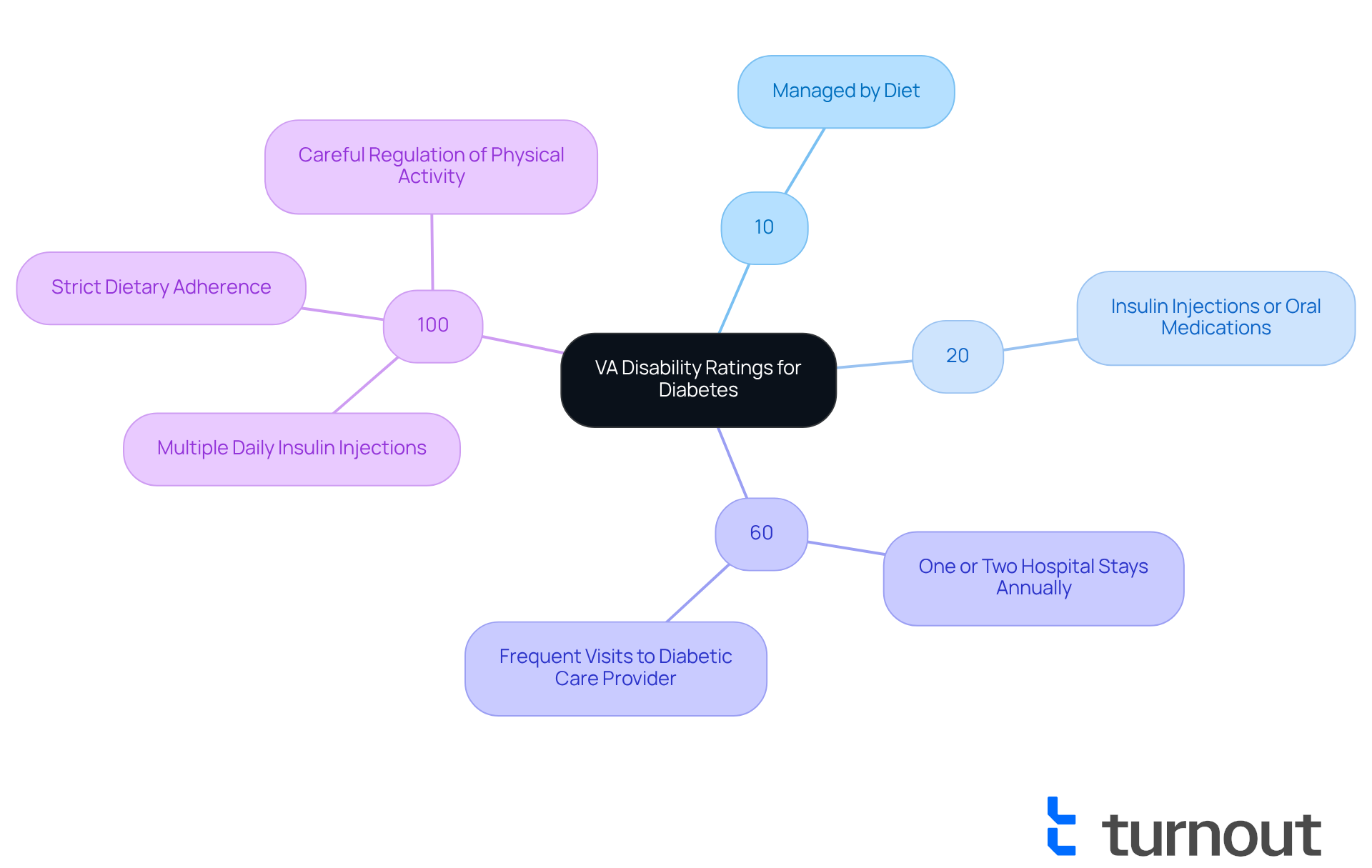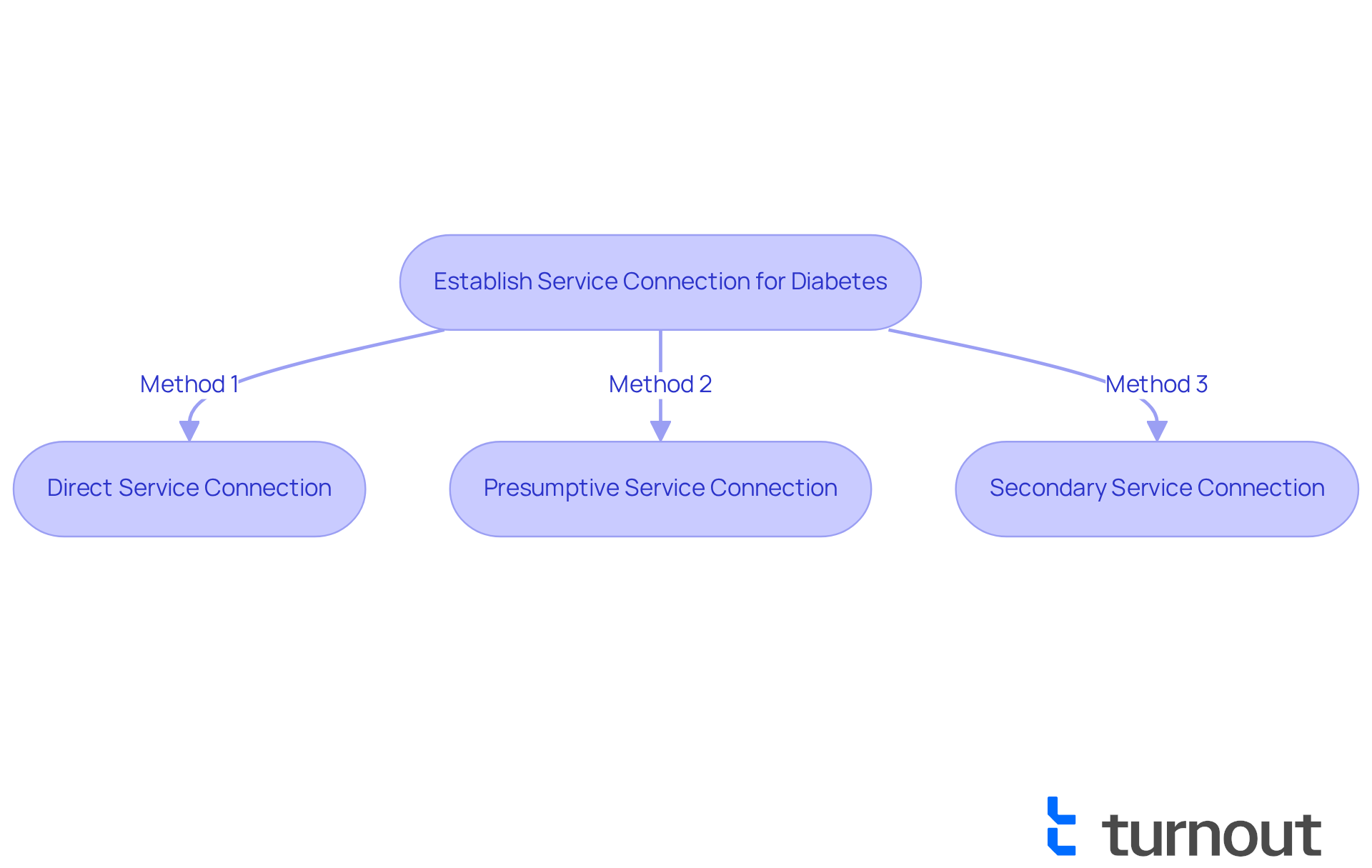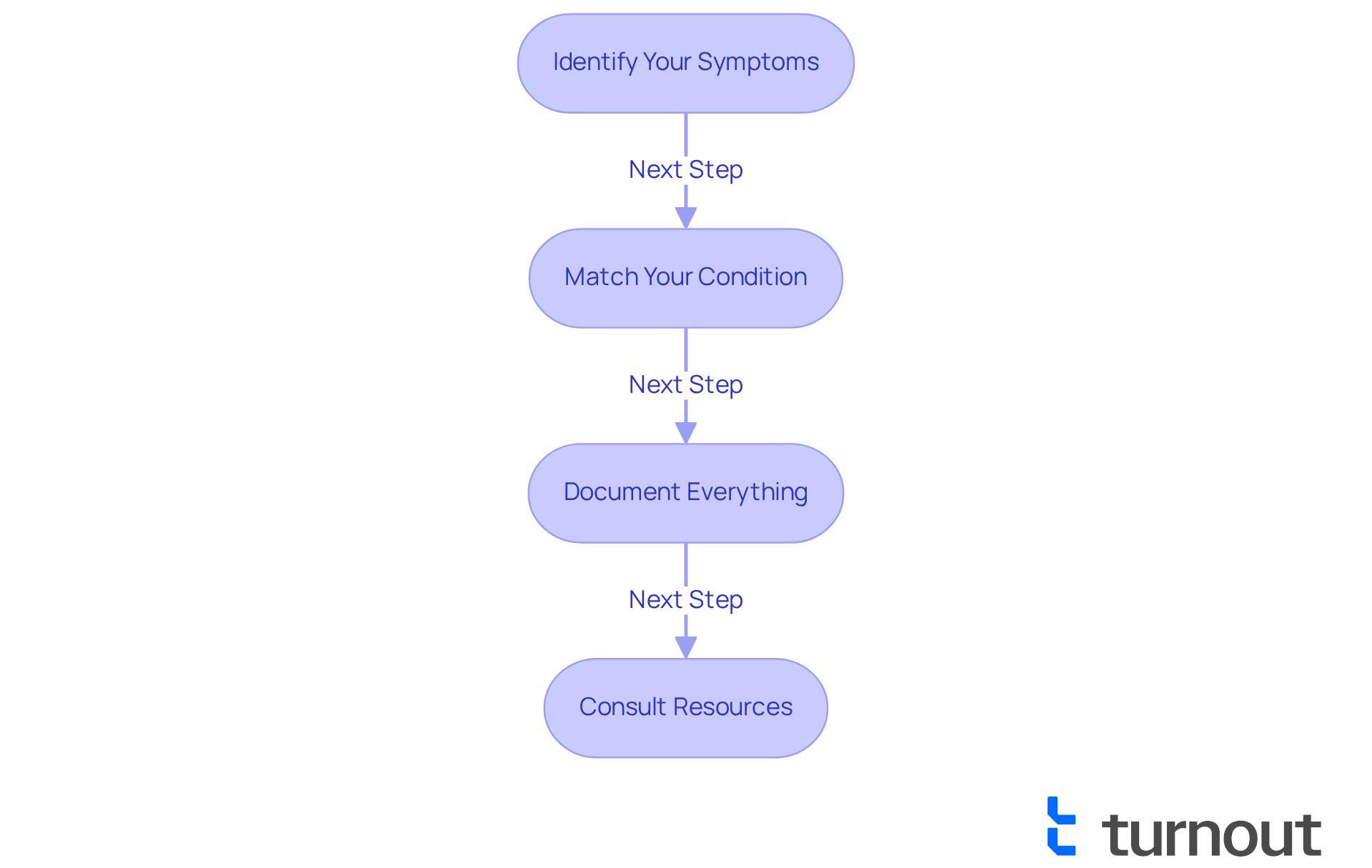Overview
The main focus of this article is to help you gain a comprehensive understanding of the VA diabetes rating chart and to guide veterans through the often complex disability evaluation process for diabetes. We recognize that navigating this process can be challenging, and we are here to support you every step of the way.
In this article, we outline the various rating percentages based on the severity of the condition. It's important to understand how these ratings work, as they directly impact the benefits you may receive. We emphasize the necessity of thorough documentation and establishing service connections, which can significantly influence the outcome of your evaluation.
You are not alone in this journey. Many veterans have faced similar challenges, and with the right information and support, it is possible to navigate this process effectively. We encourage you to take the time to understand your rights and the resources available to you. Together, we can work towards ensuring you receive the benefits you deserve.
Introduction
Navigating the complexities of the VA diabetes rating chart can feel overwhelming for many veterans. We understand that this journey is not just about numbers; it’s about securing the benefits you deserve. This guide offers a comprehensive look at how the VA evaluates diabetes, highlighting potential ratings that range from 10% to 100%, based on the severity of your condition and its management.
What challenges arise when trying to establish a service connection? It’s common to feel uncertain about how to advocate for your health needs in a system that can often seem daunting. Delving into these questions can empower you to take control of your claims process. Remember, you are not alone in this journey, and we’re here to help you navigate these complexities and ensure you receive the necessary support.
Understand the Basics of VA Disability Ratings for Diabetes
The VA diabetes rating chart shows that VA disability assessments for the illness can range from 10% to 100%, reflecting the severity of the condition and its management needs. We understand that these evaluations are influenced by how the condition affects your daily life, including treatment requirements, dietary limitations, and related complications. For example, a 10% evaluation may be assigned if the condition is managed solely through diet. In contrast, a 20% evaluation may be provided when therapy includes one or more insulin injections or oral medications alongside a restricted diet.
It's common to feel overwhelmed by the complexities of these assessments. A 60% evaluation is applicable for those experiencing one or two hospital stays annually or frequent visits to a diabetic care provider. Meanwhile, a 100% score is generally given when diabetes necessitates multiple daily insulin injections, strict dietary adherence, and careful regulation of physical activity. Understanding the VA diabetes rating chart is crucial, as it directly impacts your benefits and support.
Veterans have shared their experiences, highlighting that navigating the VA evaluation system can be daunting yet essential for obtaining the assistance you need. For instance, one veteran expressed gratitude for the insights gained in understanding their evaluation, which ultimately led to a successful appeal for a higher percentage. Remember, you are not alone in this journey.
Additionally, it's important to consider potential secondary conditions related to blood sugar issues, such as neuropathy and kidney disease, which can also influence your VA evaluations. Familiarizing yourself with the VA diabetes rating chart and gathering comprehensive medical evidence, including nexus letters and DBQs, is vital for effectively advocating for your benefits. We're here to help you through this process.

Establish Service Connection for Your Diabetes
To create a service connection for your condition, it’s important to show that your issue relates to your time in service. We understand that this process can be daunting, but there are several methods to help you navigate it:
- Direct Service Connection: You can provide medical evidence that demonstrates your condition arose during or after military service. This includes medical records, treatment history, and personal statements. For instance, a Vietnam veteran successfully raised his health rating from 10% to 20% after submitting medical records that detailed disease progression and complications. This highlights the importance of comprehensive documentation.
- Presumptive Service Connection: If you were exposed to specific conditions, such as Agent Orange, the VA may assume your condition is related to your service. Veterans who served in Vietnam between January 9, 1962, and May 7, 1975, are particularly eligible. It’s crucial to have records of your service location and dates, as this can significantly simplify the process. Notably, this health condition alone often receives a 20% VA disability rating, making it essential to establish this connection.
- Secondary Service Connection: If a condition related to blood sugar results from another service-connected issue, you can pursue it as secondary. For example, if you have a service-related condition that worsens your diabetes, collecting medical documentation to support this assertion is vital. Many veterans have successfully claimed secondary conditions like diabetic peripheral neuropathy, which can significantly enhance overall compensation.
Gather all pertinent documentation and submit it with your request to strengthen your case. Comprehensive preparation, including thorough medical documentation and personal narratives, can greatly increase the chances of approval for your diabetes-related requests according to the VA diabetes rating chart. Remember, you are not alone in this journey; we encourage you to record all issues associated with blood sugar conditions. Including these on initial claims or appeals can enhance your benefits. We're here to help you every step of the way.

Utilize the VA Diabetes Rating Chart Effectively
An essential tool for veterans seeking to understand how their condition will be evaluated is the VA Diabetes Rating Chart. We recognize that navigating this process can be overwhelming, but with the right approach, you can advocate effectively for your health and benefits.
- Identify Your Symptoms: Start by reviewing the VA diabetes rating chart to help identify the symptoms you face. This chart categorizes blood sugar condition evaluations based on treatment needs and complications as indicated in the VA diabetes rating chart, including diabetic retinopathy and neuropathy. It's common to feel uncertain about where to begin, but this step is crucial.
- Match your condition by comparing your symptoms with the descriptions in the VA diabetes rating chart. For instance, if you require insulin and adhere to dietary guidelines, you may qualify for a higher assessment. Remember, statistics indicate that one in four veterans may be affected by diabetes, which underscores the importance of the VA diabetes rating chart as an assessment tool.
- Document Everything: Keeping detailed records of your symptoms, treatments, and any complications is vital. This documentation supports your claim and helps the VA accurately assess your condition. Many veterans have shared that thorough documentation significantly increased their chances of receiving the compensation they deserve.
- Consult Resources: Don’t hesitate to use online calculators and tools to estimate your potential score based on the chart. The VA's official website offers resources that can clarify your assessment and eligibility. We’re here to help you navigate these options.
By effectively utilizing the VA diabetes rating chart, you can improve your claim preparation and advocate for the benefits you rightfully deserve. For example, Thomas D. shared how documenting his symptoms led to a successful appeal for an elevated assessment after initial rejections. This proactive approach empowers veterans and ensures they receive the necessary support for their health conditions. It's important to remember that a veteran's diabetes assessment may change over time, allowing for re-evaluation if your condition improves or worsens. You are not alone in this journey, and together, we can work towards securing the support you need.

Troubleshoot Common Issues in the VA Rating Process
Navigating the VA rating process can be challenging, and we understand that several common issues may arise. Here’s how to troubleshoot them:
- Incomplete Documentation: It’s crucial to ensure that all necessary documents are submitted with your request. Missing paperwork can lead to delays or denials. Did you know that approximately 23.8% of requests are rejected due to incomplete documentation, especially for diabetes-related conditions? Double-checking the VA's checklist for diabetes claims can help you avoid this pitfall.
- Misunderstanding Evaluations: If you receive an assessment that seems erroneous, take the time to examine the evaluation decision thoroughly. Gather evidence to support your case by comparing it with the VA diabetes rating chart. Many former service members have successfully disputed their assessments by providing additional medical records and personal declarations that clarify their situations. For instance, one individual managed to reverse a low rating by supplying comprehensive medical documentation alongside a personal narrative detailing their daily challenges with diabetes.
- Appeals Process: If your claim is denied, don’t lose hope. Remember, you have the right to appeal the decision. Collecting more evidence and considering assistance from a service organization can provide valuable guidance. Real-life examples show that veterans who persist through the appeals process often achieve favorable outcomes, such as a veteran who successfully appealed a denial after obtaining new medical evidence.
- Communication Issues: Maintaining open communication with the VA is vital. If you have questions or concerns, reaching out to their support services for clarification can be beneficial. Utilizing resources like the Veterans Crisis Line can also offer additional support and guidance. Establishing a clear line of communication can help resolve misunderstandings and strengthen your position.
By proactively addressing these common issues, you can streamline your claims process and improve your chances of receiving the benefits you deserve. Remember, you are not alone in this journey; we’re here to help.

Conclusion
Understanding the VA Diabetes Rating Chart is essential for veterans seeking to navigate the complexities of disability assessments related to diabetes. We understand that this process can feel overwhelming. This guide illuminates the various rating percentages, the significance of service connections, and offers practical strategies for effectively advocating for the benefits you deserve.
By grasping the nuances of the evaluation process, veterans can better position themselves to secure the support they need. Key points discussed include:
- The importance of comprehensive documentation
- The distinction between direct, presumptive, and secondary service connections
- The necessity of matching symptoms to the appropriate rating criteria
It’s common to encounter challenges, such as incomplete documentation and communication barriers, but addressing these issues can significantly enhance the likelihood of a successful claim. Real-life examples highlight the power of thorough preparation and persistence in overcoming obstacles.
Ultimately, the journey through the VA rating process may seem daunting, but it is crucial for veterans to remain proactive and informed. Utilizing the VA Diabetes Rating Chart effectively can empower you to advocate for your health and benefits. Remember, you are not alone in this journey. By taking these steps, you can ensure that your sacrifices are recognized and rewarded, paving the way for a healthier and more secure future.
Frequently Asked Questions
What is the range of VA disability ratings for diabetes?
VA disability ratings for diabetes can range from 10% to 100%, depending on the severity of the condition and its management needs.
How does the severity of diabetes affect the VA disability rating?
The severity of diabetes affects the rating based on how it impacts daily life, including treatment requirements, dietary limitations, and related complications.
What does a 10% evaluation for diabetes indicate?
A 10% evaluation may be assigned if the condition is managed solely through diet.
What conditions warrant a 20% evaluation for diabetes?
A 20% evaluation may be provided when therapy includes one or more insulin injections or oral medications alongside a restricted diet.
What qualifies a veteran for a 60% evaluation for diabetes?
A 60% evaluation is applicable for veterans experiencing one or two hospital stays annually or frequent visits to a diabetic care provider.
Under what circumstances is a 100% evaluation for diabetes given?
A 100% evaluation is generally given when diabetes necessitates multiple daily insulin injections, strict dietary adherence, and careful regulation of physical activity.
Why is understanding the VA diabetes rating chart important?
Understanding the VA diabetes rating chart is crucial as it directly impacts the benefits and support a veteran can receive.
What should veterans consider when navigating the VA evaluation system?
Veterans should consider potential secondary conditions related to blood sugar issues, such as neuropathy and kidney disease, which can influence their VA evaluations.
What types of medical evidence are important for advocating for VA benefits?
Gathering comprehensive medical evidence, including nexus letters and Disability Benefits Questionnaires (DBQs), is vital for effectively advocating for benefits.




